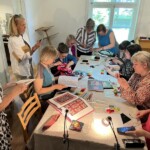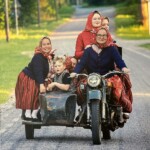Estonian Island Tour Was a Visit to Crafters’ Paradise
DAY1 – KURESSAARE is the capital of the biggest island in Estonia called Saaremaa. This is where the Handcraft Tour to Estonian Islands began. We have 15 beautiful ladies around the world, gathered to find out the charms of Saaremaa, Muhu and Kihnu islands.
We took a bus from Tallinn to Virtsu, where the short 20 minute ferry ride took us to Kuivastu on Muhu Island. Craft master Velli welcomed us in her craft store in the harbor.
We had lunch in Kaali Tavern and also a chance to visit the meteor crater nearby.
After checking in to Arensburg Hotel we were ready for a town tour. Marje guided us through the beautiful streets and squares of the downtown Kuressaare. The final stop was the medieval castle.
DAY2 – LÜMANDA AND LEEDRI are just two of many lovely villages in Saaremaa. But before we got there, we had the first workshop of the Handcraft Tour to Estonian Islands.
Imbi Padar, a passionate knitter and researcher of local mitten knitting art, welcomed us in Kuressaare Art Gallery. She had set up a table full of amazing samples of 59 different cuffs from Saaremaa.
After a small introductory we started to work on our own mitten cuff in Mustjala style. At the same time, some students sneaked downstairs to admire some local jewelry and designer clothing.
Bus took us to lunch to Lümanda Restaurant, where some fresh vegetables, tasty pork with salads were served to us.
Then we drove to Leedri village. A quilter Jaanika Tiitson guided us through her home village with such a long history, strong families, and beautiful landscapes.
Also located in the same village is Saaremaa juniper syrup makers Kadakakoda. We got to admire the beautiful home and also taste some really fantastic produce.
Regardless of a little drizzle, we visited the Mihkli open air museum in Viki. We learned why this 300 years old farm is exceptional among many open air museums. And the reason is: all the buildings have been there – nothing was added, nothing was taken away. It was purchased from the original owner Peeter Reht, whose ancestors had lived there for centuries.
Our last attraction of the day was a visit to a lime quarry. We learned a lot about the old process, saw some kilns and had a pleasant walk in the woods.
DAY3 – KAARMA AND ANGLA AND LAIMJALA got into our hearts. Picturesque landscapes, cute villages, and warm people surrounded us everywhere. We started our day at Kuressaare Vacation school textile department. There was huge classroom full of looms on the outskirts of the town. Teachers Kaie and Anne showed us around their kingdom.
Next we visited an ancient church at Kaarma. Built in 1260, bell-tower added in 1410, it is one of the most ancient churches at the island. Sarah sang us to prove the amazing acoustics. Although the space was rather narrow we managed to climb up the tower.
We continued our trip to Mareli’s farm, who is a craft master specializing mostly in felting. She is also organizing courses where one can make local traditional costumes.
We had lunch at Angla windmill hill followed by a workshop in felting. It was really cute to see what people choose to create, and how lovely they came out.
For the evening we went to Nooda farm, where Mare hosted a great homemade dinner, some crafts and dancing.
DAY4 – EMBROIDERING IN MUHU is a challenge, because there are so many beautiful and well mastered embroidered items around. On the other hand it encourages you to try to learn this skill. And as it’s so hard at first you appreciate the work of the local masters even more.
We had an embroidery workshop with Alliki and Velli this morning, where we learned to draw a strawberry with the yarn and needle.
An old parish house was turned into craft house in Liiva, the capital of Muhu, also displayed couple of exhibitions.
After tasty lunch we headed to the local museum and had an interesting tour on their premises.
Muhu’s traditional clothing is very colorful and finely made. Easily a pair of gloves could have 160 stitches on a round.
Muhu has beautiful and bright clothes for both men and women.
Before heading home we stopped at Männiku Farm where Sirje Tüür is creating her fantastic embroidered masterpieces.
DAY5 – THE COLORS IN MUHU are amazingly bright and beautiful. All the mittens, gloves, stockings and sweaters are knitted with such a great taste and talent.
Our day started in Hellamaa, where a temporary exhibition of old textiles from people’s homes was put on. We had a chance to investigate them close up and admire the fine pieces of art.
Then we continued to the ostrich farm in Nautse. After a short stop at a second hand shop we visited a designer’s studio for some great fashion. The designer Triinu Traumann introduced us her work and told us how she was using Muhu traditional patterns in her fashion.
Today’s workshop was on Muhu knitted cuffs. Alliki and Velli taught us some casting on tricks. With some bright colors and thin needles we recreated a cuff of one museum item.
We had dinner in the southern harbor in a fish restaurant. Delicious food, good company and mild breeze, evening well spent!
Getting back to our great farm hotel, we saw a smoke raising from the chimney. So now we are getting ready for sauna.
DAY6 – TÕSTAMAA is the capital of inlay knitting in Estonia. It is also very conveniently located between Muhu Island and Kihnu Island. So getting off from the ferry, that’s where we headed.
Anu Randmaa and her team welcomed us at Tõstamaa handicraft center. They had prepared a nice workshop for us: in the inlay knitting technique, also called ROOSIMINE in Estonian, we started to knit a pin cushion.
Lunch place was located on Ermistu lake, where we took the chance and dipped in. It was a beautiful hot summer day.
Before we started heading towards Pärnu, we got some shopping done at the craft store.
Pärnu is the summer capital of Estonia: beautiful, wide beach with fine white sand, lots of cafes and restaurants, many joyful, vacationing people wonderful atmosphere.
DAY7 – KIHNU is a really small island off the Estonian western coast near Pärnu.
We took the ferry in Munalaiu Harbor and in one hour we reached Kihnu.
A truck was waiting to take us for a tour. The first stop was at a sheep farmers. They had hung a lot of local traditional costume skirts to air. It was like an exhibition for us. Their yarn is absolutely beautiful. Many of us couldn’t resist buying some.
We drove by northern harbor, local cemetery and arrived at the museum.
Mare, our guide on the island, walked us through the interesting history of Kihnu Island.
After delicious home made meal at Sireli farm by Eve, we started the workshop. Our teacher Elly is the well known sweater knitter. Kihnu sweater is called a troi. Elly had charted us her favorite sleeve ending. Now we were to knit some wrist warmers in the same troi style.
Evening ended with sauna and swimming in a pond. Then we walked to the seaside passing some quiet idyllic rural landscapes and admired the sunset.
DAY8 – KIHNU is still quite small island, but for a crafter, there are many things to do and admire.
Some of us stayed overnight at Veronika’s in Pärnamõisa, a beautiful B&B in Lina Village. So our morning started with a 1,4 km walk on picturesque rural roads.
After breakfast, we started our class which today was on different braiding techniques from Kihnu Island. The weather was pleasant, warm breeze from nearby sea, we decided to stay outside.
We learned three ways of braiding, which you can use for tying or decoration edging or handle for a project bag.
We had lunch at Sireli Farm, then we continued to the local orthodox church.
Before fairy, we had enough time to climb up the lighthouse. Breathtakingly beautiful view, accompanied by a quite strong wind, made it a memorable experience.
You are very welcome to join us next summer. Please write us at info@nordicknitters.com for info and reservation.
































































